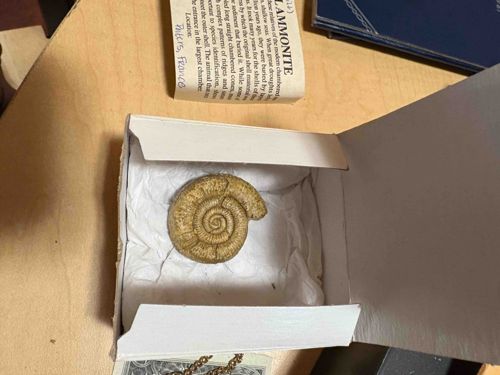
Ammonite Fossil
The item is identified as an ammonite fossil, housed within a small, open cardboard box lined with white tissue paper. The fossil itself is a well-preserved, coiled shell structure, exhibiting the characteristic planispiral or involute coiling common to ammonites. Its color is a uniform light brown or 'sandstone' hue, suggesting it is composed of sedimentary rock material, likely a calcareous or argillaceous matrix. The surface of the fossil displays fine, distinct ridges or ribs that radiate outwards from the central spire, indicating good preservation of the external shell morphology. These ribs are evenly spaced and contribute to the overall texture of the piece. The fossil appears to be generally intact with no visible signs of major breakage or repair, though some minor surface abrasions or natural imperfections from its geological history might be present upon closer inspection. Its size is suitable for display within the provided box, suggesting it is likely hand-sized or smaller, possibly a few inches in diameter. The craftsmanship, in this context, refers to the natural geological processes that led to its excellent preservation. Accompanying information, partially visible from an adjacent paper, identifies it as an 'AMMONITE' and specifies its location of origin as 'Puiters, France'. This indicates its geological provenance and provides important context for its scientific and collectible value. The visible text also mentions characteristics related to the ammonite's anatomy, such as 'chambered conch' and the animal's dwelling within the 'largest chamber', further confirming its identity. Based on ammonite types found globally and mentioned details, it likely dates from the Mesozoic Era (approximately 252 to 66 million years ago).
AI-Generated Appraisal Disclaimer
Estimated Value
$40-75
Basic Information
Category
Fossil
Appraised On
December 19, 2025
Estimated Value
$40-75
Item Description
The item is identified as an ammonite fossil, housed within a small, open cardboard box lined with white tissue paper. The fossil itself is a well-preserved, coiled shell structure, exhibiting the characteristic planispiral or involute coiling common to ammonites. Its color is a uniform light brown or 'sandstone' hue, suggesting it is composed of sedimentary rock material, likely a calcareous or argillaceous matrix. The surface of the fossil displays fine, distinct ridges or ribs that radiate outwards from the central spire, indicating good preservation of the external shell morphology. These ribs are evenly spaced and contribute to the overall texture of the piece. The fossil appears to be generally intact with no visible signs of major breakage or repair, though some minor surface abrasions or natural imperfections from its geological history might be present upon closer inspection. Its size is suitable for display within the provided box, suggesting it is likely hand-sized or smaller, possibly a few inches in diameter. The craftsmanship, in this context, refers to the natural geological processes that led to its excellent preservation. Accompanying information, partially visible from an adjacent paper, identifies it as an 'AMMONITE' and specifies its location of origin as 'Puiters, France'. This indicates its geological provenance and provides important context for its scientific and collectible value. The visible text also mentions characteristics related to the ammonite's anatomy, such as 'chambered conch' and the animal's dwelling within the 'largest chamber', further confirming its identity. Based on ammonite types found globally and mentioned details, it likely dates from the Mesozoic Era (approximately 252 to 66 million years ago).
Related Tags
Get Your Items Appraised
Instant estimates of your treasures with AI-powered instant appraisals